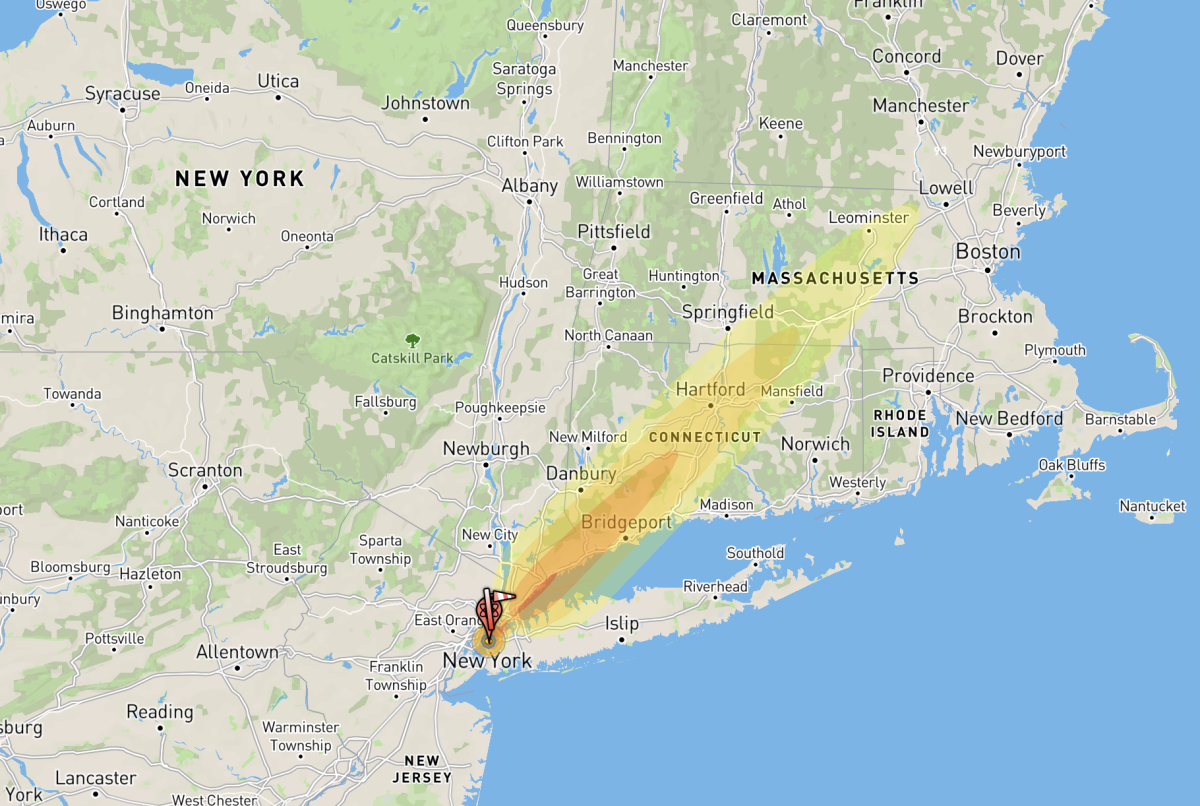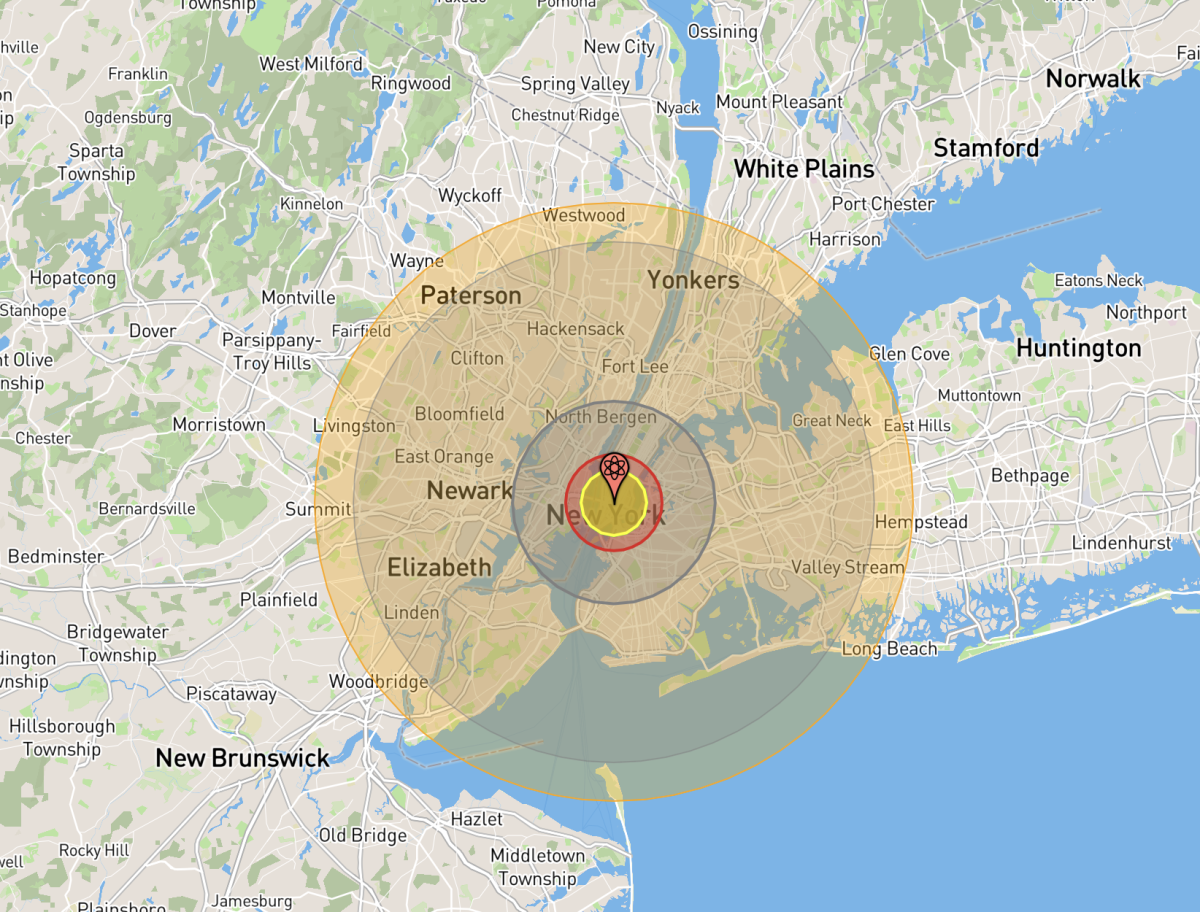The new nuclear gravity bomb being developed under the administration of President Joe Biden is orders of magnitude less powerful than the biggest bombs in history.
The Pentagon announced last month that it was working on the B61-13, the latest variant in a line of nuclear weapons that were first produced in the 1960s. With an estimated maximum explosive yield of 360 kilotons, the warhead is among the most powerful in the current U.S. arsenal.
A map showing a hypothetical B61-3 explosion in New York City—created using Nukemap, an online tool created by historian of science and nuclear technology Alex Wellerstein—shows that the new bomb would destroy a huge chunk of Manhattan, killing over 778,000 people and injuring more than 1 million others.
People and buildings would be vaporized by a B61-3 fireball within a roughly half-mile radius. Miles away, buildings would be demolished and deaths and injuries would be widespread. Radioactive fallout would be seen in the larger Northeast region.
However, the B61-13 blast pales in comparison to history's most destructive nuclear weapons. The most powerful U.S. weapon ever tested, the TX-21 "Shrimp" bomb, unleashed 15 megatons of explosive power during the "Castle Bravo" test at Bikini Atoll in the Marshall Islands on March 1, 1954.

A map showing the TX-21 exploding in New York City reveals a fireball with a 2.3 mile radius and blast damage seen as far as 18 miles away. More than 4 million people would be killed, with over 3.4 million others injured. Radiation burns would occur more than 21 miles away.

While the TX-21 was the most powerful U.S. bomb tested, the country built one weapon that was even more destructive—the 25-megaton B41 thermonuclear bomb. A map showing the B41 exploding in New York City reveals that the bomb blast would kill over 4.8 million people and injure almost 3.7 million more.
A B41 detonation would create a fireball with a radius of over 2.8 miles. Blast damage would be seen as far as 21.3 miles away, with thermal radiation burns occurring within a radius of 25.6 miles.

An additional map shows the B41's radioactive plume traveling northeast and extending over most of New England, crossing the Canadian border and making it all the way to the Gulf of St. Lawrence.

By comparison, a map showing the B61-13's radioactive plume traveling northeast shows that it would extend into northern Massachusetts, ending just outside of Lowell.

The Soviet Union created and tested a nuclear bomb that was twice as powerful as the B41 and about 139 times more powerful than the B61-13. The 50-megaton Soviet AN602—more often referred to as "Tsar Bomba," or the "king of bombs"—was responsible for the largest explosion ever created by humans during a test on October 30, 1961.
A Nukemap image showing the Tsar Bomba exploding over New York City reveals fireball that would vaporize everything within a radius of more than 3.7 miles. Blast damage would be seen almost 27 miles away, with radiation burns almost 32 miles away. The explosion would kill over 6.3 million people and injure over 3.9 million others.

Although the Tsar Bomba was tested at 50 megatons, the weapon was designed to be twice as powerful at 100 megatons. A map imagining the 100-megaton version of the Tsar Bomba on New York City shows even more destruction.
At 100 megatons, the bomb would immediately kill over 7.9 million people and injure more than 4 million others. The vaporizing fireball would have a radius of almost 5 miles and blast damage would happen within a radius of nearly 34 miles. Everyone within 45 miles would receive third-degree burns from radiation.

The most powerful bomb in the current U.S. arsenal, the B83 nuclear gravity bomb, is more than three times the explosive yield of the B61-13 at 1.2 megatons. While the B83 is far less powerful than history's biggest bombs, it would still result in a massive death toll of around 3.2 million and 3.6 million injuries.
A B83 exploding in New York would create fireball of over 2 miles, with massive destruction and damage would be seen up to 6.5 miles away. Radiation burns could be expected within a 19-mile radius.

The Biden administration announced plans to retire the B83 in 2022. However, the weapon still remains in the U.S. stockpile, with the new B61-13 having been announced with the larger bomb's impending retirement in mind.
The Federation of American Scientists (FAS), a group dedicated to reducing nuclear weapons, has said that the development of the B61-13 was likely "a political maneuver to finally get rid of" the B83.
Newsweek reached out for comment to FAS via email on Tuesday.
Prior to becoming president, Biden frequently spoke out against nuclear weapons, pledging during his 2020 campaign to "work to bring us closer to a world without nuclear weapons, so that the horrors of Hiroshima and Nagasaki are never repeated."
A National Security Council spokesperson previously told Newsweek that the president's pursuit of the B61-13 "in no way detracts from the president's work of bringing us closer to a world without nuclear weapons," while pointing out that the new weapon would not increase the overall size of the stockpile.
"The Biden administration has taken a balanced approach between maintaining a safe, secure and effective nuclear deterrent and strong and credible extended deterrence, and taking those steps needed to reduce the global salience of nuclear weapons and bring us closer to a world without nuclear weapons," the spokesperson said.
Uncommon Knowledge
Newsweek is committed to challenging conventional wisdom and finding connections in the search for common ground.
Newsweek is committed to challenging conventional wisdom and finding connections in the search for common ground.
fairness meter
To Rate This Article
About the writer
Aila Slisco is a Newsweek night reporter based in New York. Her focus is on reporting national politics, where she ... Read more





